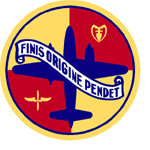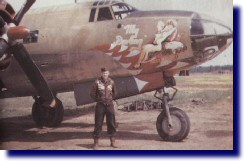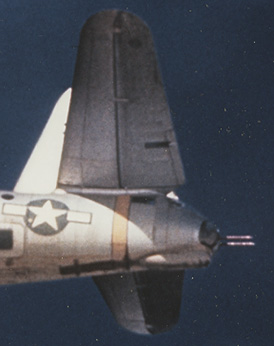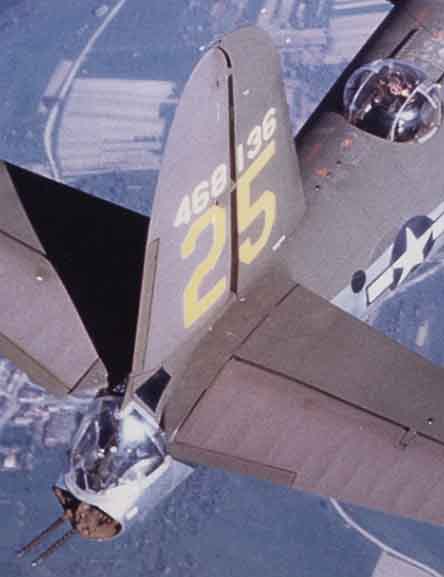|
|
 The Squadron Insignias
The Squadron Insignias
|
 441st Bomb Squadron
441st Bomb Squadron
|
|
|
 The
initial 441st Squadron insignia consisted of an outline
of the U.S. map with the lions heart escutcheon
above it and the Air Corps winged prop over it on the
left. Accross the map ran a scroll with the Latin motto
Finis Origine Pendet (the end depends upon the
beginning). This insignia was used by the squadron from
its inception in 1943 until early 1944 and was commonly
painted on the nose of the aircraft. The early A-2 jacket
patch used the same insignia made out of tufted cloth. The
initial 441st Squadron insignia consisted of an outline
of the U.S. map with the lions heart escutcheon
above it and the Air Corps winged prop over it on the
left. Accross the map ran a scroll with the Latin motto
Finis Origine Pendet (the end depends upon the
beginning). This insignia was used by the squadron from
its inception in 1943 until early 1944 and was commonly
painted on the nose of the aircraft. The early A-2 jacket
patch used the same insignia made out of tufted cloth.
 In
early 1944, while on Sardinia, the Squadron altered
their design background to a quadranted circle of red
and yellow overlaid with a royal blue silhouette of
a B-26. The winged Air Corp prop was placed in the lower
left quadrant and the Lions Heart in the upper
right quadrant. At this time as well, the patch was
changed on the A-2 jackets to this same insignia. The
patch was made of leather. In
early 1944, while on Sardinia, the Squadron altered
their design background to a quadranted circle of red
and yellow overlaid with a royal blue silhouette of
a B-26. The winged Air Corp prop was placed in the lower
left quadrant and the Lions Heart in the upper
right quadrant. At this time as well, the patch was
changed on the A-2 jackets to this same insignia. The
patch was made of leather.
|
 442nd Bomb Squadron
442nd Bomb Squadron
|
|
|
 The
442nd Squadron's orignial insignia was a cartoon figure
of Donald Duck cradling a bomb and charging forward.
This design which, caused the 442nd to be nicknamed the
Ugly Duckling Squadron, was used throughout the
war. The only alteration was fitting the duck with a
USAAF shirt, tie, and cap in early 1945. The
442nd Squadron's orignial insignia was a cartoon figure
of Donald Duck cradling a bomb and charging forward.
This design which, caused the 442nd to be nicknamed the
Ugly Duckling Squadron, was used throughout the
war. The only alteration was fitting the duck with a
USAAF shirt, tie, and cap in early 1945.
|
 443rd Bomb Squadron
443rd Bomb Squadron
|
|
|
 The
443rd throughout the war used a black African native
figure crouching in jungle foliage and blowing a bomb
out of a blowpipe. The figure held a shield with the
U.S. star insignia. The
443rd throughout the war used a black African native
figure crouching in jungle foliage and blowing a bomb
out of a blowpipe. The figure held a shield with the
U.S. star insignia.
|
 444th Bomb Squadron
444th Bomb Squadron
|
|
|
 A
Walt Disney style Thumper rabbit in foot-stomping
pose was the original 444th Squadron emblem. Later the
Squadron changed the design by having the rabbit riding
on a shark mouth painted bomb, wearing long johns, helmet,
goggles and scarf and holding a blunderbuss. A
Walt Disney style Thumper rabbit in foot-stomping
pose was the original 444th Squadron emblem. Later the
Squadron changed the design by having the rabbit riding
on a shark mouth painted bomb, wearing long johns, helmet,
goggles and scarf and holding a blunderbuss.
The 444th Squadron adopted the
famous shark-mouth insignia while stationed at Tafaraoui
early in 1943. This marking continued with the squadron
through V-E day.

|
 Group Identification Markings
Group Identification Markings
|
 Tail Band
Tail Band
|
|
|
 When
the 320th commenced combat operations in North Africa
there was initially no group identification on the aircraft.
In July 1943, however, the 42nd Bomb Wing ordered that
a 10 inch band be painted around the fuselage of all
B-26s just behind the rear gunner's position under the
stabilizer. This was done for the remainder of the war.
When natural aluminum aircraft arrived to the MTO during
February 1944, additional thin black banding around
the stripe was used to better demarcate the Groups tail
banding. Group recognition colors assigned were: yellow
for the 320th, red for the 17th, and white for the 319th. When
the 320th commenced combat operations in North Africa
there was initially no group identification on the aircraft.
In July 1943, however, the 42nd Bomb Wing ordered that
a 10 inch band be painted around the fuselage of all
B-26s just behind the rear gunner's position under the
stabilizer. This was done for the remainder of the war.
When natural aluminum aircraft arrived to the MTO during
February 1944, additional thin black banding around
the stripe was used to better demarcate the Groups tail
banding. Group recognition colors assigned were: yellow
for the 320th, red for the 17th, and white for the 319th.
|
 Battle numbers
Battle numbers
|
|
|
In October of 1943, 48-inch high
battle numbers were ordered to be painted on both sides
of the plane's rudder. These battle numbers replaced
the "last three digits" of the  serial
number that had previously been utilized for aircraft
identification. As in pre-war
Air Corps practice, aircraft of the first Squadron were
asssigned numbers between 1 and 24, the second Squadron,
25 to 49, the third 50 to 74, and the fourth squadron
75 to 99. The 320th painted its battle numbers below
the serial number in military block-style (angled corners)
and were usually wider in stroke than other MTO units,
namely the 319th and 17th. Initially, battle numbers
were painted in white, but by the end of 1943, after
the 320th moved to Sardinia, the group color, yellow,
was used in order to better distinguish the ships in
combined formations. When natuaral metal planes started
arriving, as with the tail banding, the battle numbers
were outlined in black.Serial numbers were changed to
black as well. serial
number that had previously been utilized for aircraft
identification. As in pre-war
Air Corps practice, aircraft of the first Squadron were
asssigned numbers between 1 and 24, the second Squadron,
25 to 49, the third 50 to 74, and the fourth squadron
75 to 99. The 320th painted its battle numbers below
the serial number in military block-style (angled corners)
and were usually wider in stroke than other MTO units,
namely the 319th and 17th. Initially, battle numbers
were painted in white, but by the end of 1943, after
the 320th moved to Sardinia, the group color, yellow,
was used in order to better distinguish the ships in
combined formations. When natuaral metal planes started
arriving, as with the tail banding, the battle numbers
were outlined in black.Serial numbers were changed to
black as well.
|
 Spinners and Cowlings
Spinners and Cowlings
|
|
|
 Mid-way
through the war, the aircraft spinners of many of the
aircraft were painted red. In addition, while stationed
in Dijon,France, the cowlings of many of the aircraft
were painted red as well. This was particularly true
of the 441st Bomb Squadron.Also seen, but far less common
were yellow painted cowlings. Radio direction finder
housings under the nose were also painted red so that
crews would not bump them. Mid-way
through the war, the aircraft spinners of many of the
aircraft were painted red. In addition, while stationed
in Dijon,France, the cowlings of many of the aircraft
were painted red as well. This was particularly true
of the 441st Bomb Squadron.Also seen, but far less common
were yellow painted cowlings. Radio direction finder
housings under the nose were also painted red so that
crews would not bump them.
|

Copyright(c) 2006 320th History Preservation. All rights reserved.
|





















 The Squadron Insignias
The Squadron Insignias 441st Bomb Squadron
441st Bomb Squadron







